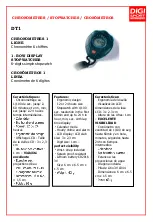
These estimates are provided and supported by Firstbeat
Analytics. For more information, go to
.
NOTE: The estimates may seem inaccurate at first. The
watch requires you to complete a few activities to learn
about your performance.
Training status: Training status shows you how your
training affects your fitness and performance. Your
training status is based on changes to your training
load and VO2 max. over an extended time period.
VO2 max.: VO2 max. is the maximum volume of oxygen
(in milliliters) you can consume per minute per kilogram
of body weight at your maximum performance (
). Your watch displays
heat and altitude corrected VO2 max. values when
you are acclimating to high heat environments or high
altitude (
Heat and Altitude Performance Acclimation,
).
Training load: Training load is the sum of your excess
post-exercise oxygen consumption (EPOC) over the last
7 days. EPOC is an estimate of how much energy it
takes for your body to recover after exercise (
).
Training load focus: Your watch analyzes and distributes
your training load into different categories based on
the intensity and structure of each activity recorded.
Training load focus includes the total load accumulated
per category, and the focus of the training. Your watch
displays your load distribution over the last 4 weeks
(
).
Recovery time: The recovery time displays how much time
remains before you are fully recovered and ready for
the next hard workout (
).
Training Status Levels
Training status shows you how your training affects your
fitness level and performance. Your training status is
based on changes to your training load and VO2 max. over
an extended time period. You can use your training status
to help plan future training and continue improving your
fitness level.
Peaking: Peaking means that you are in ideal race
condition. Your recently reduced training load is
allowing your body to recover and fully compensate for
earlier training. You should plan ahead, since this peak
state can only be maintained for a short time.
Productive: Your current training load is moving your
fitness level and performance in the right direction.
You should plan recovery periods into your training to
maintain your fitness level.
Maintaining: Your current training load is enough to
maintain your fitness level. To see improvement, try
adding more variety to your workouts or increasing your
training volume.
Recovery: Your lighter training load is allowing your body
to recover, which is essential during extended periods
of hard training. You can return to a higher training load
when you feel ready.
Unproductive: Your training load is at a good level, but
your fitness is decreasing. Your body may be struggling
to recover, so you should pay attention to your overall
health including stress, nutrition, and rest.
Detraining: Detraining occurs when you are training much
less than usual for a week or more, and it is affecting
your fitness level. You can try increasing your training
load to see improvement.
Overreaching: Your training load is very high and
counterproductive. Your body needs a rest. You should
give yourself time to recover by adding lighter training
to your schedule.
No Status: The device needs one or two weeks of training
history, including activities with VO2 max. results from
running or cycling, to determine your training status.
Tips for Getting Your Training Status
The training status feature depends on updated
assessments of your fitness level, including at least
two VO2 max. measurements per week. Your VO2 max.
estimate is updated after outdoor runs or rides with power
during which your heart rate reached at least 70% of
your maximum heart rate for several minutes. Indoor run
activities do not generate a VO2 max. estimate in order
to preserve the accuracy of your fitness level trend. You
can disable VO2 max. recording for ultra run and trail run
activities if you do not want those run types to affect your
VO2 max. estimate (
Activities and App Settings, page 16
).
To get the most out of the training status feature, you can
try these tips.
• At least two times per week, run or ride outdoors with a
power meter, and reach a heart rate higher than 70% of
your maximum heart rate for at least 10 minutes.
After using the device for one week, your training status
should be available.
• Record all of your fitness activities on this device, or
enable the Physio TrueUp feature, allowing your device
to learn about your performance (
Performance Measurements, page 60
).
Heat and Altitude Performance Acclimation
Environmental factors such as high temperature and
altitude impact your training and performance. For
example, high altitude training can have a positive impact
on your fitness, but you may notice a temporary VO2 max.
decline while exposed to high altitudes. Your D2 Mach 1
watch provides acclimation notifications and corrections
to your VO2 max. estimate and training status when the
temperature is above 22ºC (72ºF) and when the altitude is
above 800 m (2625 ft.). You can keep track of your heat
and altitude acclimation in the training status glance.
Appearance
33
Summary of Contents for D2 MACH1
Page 1: ...D2 MACH1 Owner sManual ...
Page 8: ......
Page 85: ......
Page 86: ...support garmin com June 2022 190 02855 00_0B ...
















































